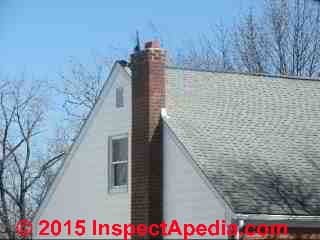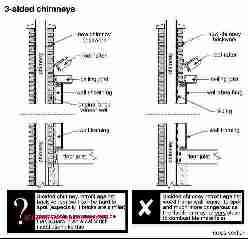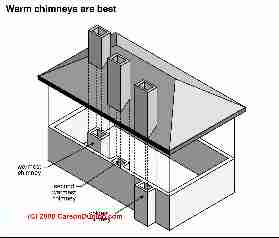 How to spot 3-sided Chimneys & Why They are a Hazard
How to spot 3-sided Chimneys & Why They are a Hazard
- POST a QUESTION or COMMENT about three-sided chimneys: inspection, recognition, reporting, hazards, repairs
Three-sided chimney hazards:
The term "three-sided chimney" refers to masonry chimneys that have three sides exposed to the outdoor elements - a design that may be contrasted with chimneys built into rather than onto buildings.
A chimney built into a building has only one side exposed on an exterior wall, while still other chimneys that pass through the building interior may have no sides exposed to the outdoors until the chimney exits through the building roof.
This article describes visual clues to pick up on unsafe three-sided chimneys. Our sketch of a three-sided chimney is courtesy of Carson Dunlop Associates, a Toronto home inspection, education & report writing tool company [ carsondunlop.com ].
InspectAPedia tolerates no conflicts of interest. We have no relationship with advertisers, products, or services discussed at this website.
- Daniel Friedman, Publisher/Editor/Author - See WHO ARE WE?
Three-Sided Chimney Fire Hazards
 A three-sided or "three walled chimney" is one which does not provide full masonry thickness or fire protection around all sides of the chimney flue.
A three-sided or "three walled chimney" is one which does not provide full masonry thickness or fire protection around all sides of the chimney flue.
As Carson Dunlop Associates [at REVIEWERS] sketch shows, a 3-sided chimney may be constructed when a chimney is added to a building as a retrofit project.
An amateur worker may place the chimney flue tiles right against the building exterior wall, covering only the flue's exposed surfaces with brickwork.
Three sided chimneys can be a very serious fire risk because the chimney has been built close to or even directly against combustible building materials without the necessary fire clearance and masonry fire protection needed.
Chimney Location, Draft & Performance
As these Carson Dunlop Associates [at REVIEWERS] sketches show, a warm chimney works best at developing good draft which in turn helps assure that the appliances or fireplaces being vented by the chimney will perform properly.
Interior-Routed Chimneys Help Heat the Building
Construction of a chimney that passes through the interior of a home was originally done to get the most heat out of the chimney and into the occupied space during cold weather.
Even though it is easier to build the chimney on the outside wall of a building, a central chimney provided heat through its masonry to the building interior on all floors.
An additional benefit of constructing the masonry chimney on a route passing through the building interior was lower construction cost. When the brick chimney is routed through the building interior it can be built using common brick rather than more costly face brick that should be used where the brick is exposed to the weather.
Watch out: wherever a masonry chimney is constructed, where it must pass by wood framing the chimney should be separated from wood or other combustibles by a two-inch air space. Depending on fire code requirements where you live it may be permitted or required to fill the air space with non-combustible insulation such as mineral wool or to use a fireproof insulating sealant.
Draft: Thermal Performance of Chimneys
A chimney's thermal performance provides the "draft" by maintaining a warm interior lining. The draft is the pressure difference between ambient air and the less dense flue gases within the chimney. The lighter gases are buoyant and rise to be displaced by heavier ambient air.
The chimney must contain the hot gases and protect the surrounding materials against combustion. Residential masonry chimneys must protect the building while under exposure to 1000°F continuous flue gas temperature although most gas appliances operate with a flue gas temperature of about 300°F and oil burners with a flue gas temperature of about 500°F.
See DRAFT REGULATORS - barometric dampers and
DRAFT REGULATORS / HOODS GAS HEATERS for details about draft, how it works, how it is measured, why it is important for safe appliance operation.
...
Continue reading at BRACKET CHIMNEY COLLAPSE & FIRE RISKS or select a topic from the closely-related articles below, or see the complete ARTICLE INDEX.
Or see these
Recommended Articles
Suggested citation for this web page
THREE-SIDED CHIMNEYS at InspectApedia.com - online encyclopedia of building & environmental inspection, testing, diagnosis, repair, & problem prevention advice.
Or see this
INDEX to RELATED ARTICLES: ARTICLE INDEX to CHIMNEYS & FLUES
Or use the SEARCH BOX found below to Ask a Question or Search InspectApedia
Ask a Question or Search InspectApedia
Try the search box just below, or if you prefer, post a question or comment in the Comments box below and we will respond promptly.
Search the InspectApedia website
Note: appearance of your Comment below may be delayed: if your comment contains an image, photograph, web link, or text that looks to the software as if it might be a web link, your posting will appear after it has been approved by a moderator. Apologies for the delay.
Only one image can be added per comment but you can post as many comments, and therefore images, as you like.
You will not receive a notification when a response to your question has been posted.
Please bookmark this page to make it easy for you to check back for our response.
IF above you see "Comment Form is loading comments..." then COMMENT BOX - countable.ca / bawkbox.com IS NOT WORKING.
In any case you are welcome to send an email directly to us at InspectApedia.com at editor@inspectApedia.com
We'll reply to you directly. Please help us help you by noting, in your email, the URL of the InspectApedia page where you wanted to comment.
Citations & References
In addition to any citations in the article above, a full list is available on request.
- Thanks to Luke Barnes for suggesting that we add text regarding the hazards of shared chimney flues. USMA - Sept. 2008.
- NFPA 211 - Standards for Chimneys & Fireplaces, NFPA 211: Standard for Chimneys, Fireplaces, Vents, and Solid Fuel-Burning Appliances, 2006 Edition (older editions and standards are found at the same bookstore)
- NFPA #211-3.1 1988 - Specific to chimneys, fireplaces, vents and solid fuel burning appliances.
- NFPA # 54-7.1 1992 - Specific to venting of equipment with fan-assisted combustion systems.
- GAMA - Gas Appliance Manufacturers' Association has prepared venting tables for Category I draft hood equipped central furnaces as well as fan-assisted combustion system central furnaces.
- National Fuel Gas Code, an American National Standard, 4th ed. 1988 (newer edition is available) Secretariats, American Gas Association (AGA), 1515 Wilson Blvd., Arlington VA22209, and National Fire Protection Association (NFPA), Batterymarch Park, Quincy MA 02269. ANSI Z223.1-1988 - NFPA 54-1988. WARNING: be sure to check clearances and other safety guidelines in the latest edition of these standards.
- Fire Inspector Guidebook, A Correlation of Fire Safety Requirements Contained in the 1987 BOCA National Codes, (newer edition available), Building of ficials and Code Administrators International, Inc. (BOCA), Country Club HIlls, IL 60478 312-799-2300 4th ed. Note: this document is reissued every four years. Be sure to obtain the latest edition.
- Uniform Mechanical Code - UMC 1991, Sec 913 (a.) Masonry Chimneys, refers to Chapters 23, 29, and 37 of the Building Code.
- New York 1984 Uniform Fire Prevention and Building Code, Article 10, Heating, Ventilating, and Air Conditioning Requirements
- New York 1979 Uniform Fire Prevention & Building Code, The "requirement" for 8" of solid masonry OR for use of a flue liner was listed in the One and Two Family Dwelling Code for New York, in 1979, in Chapter 9, Chimneys and Fireplaces, New York 1979 Building and Fire Prevention Code:
- "Top Ten Chimney (and related) Problems Encountered by One Chimney Sweep," Hudson Valley ASHI education seminar, 3 January 2000, contributed by Bob Hansen, ASHI
- Chimney Inspection Checklist, Carson Dunlop, Associates, Toronto, Ontario
- "Rooftop View Turns to Darkness," Martine Costello, Josh Kovner, New Haven Register, 12 May 1992 p. 11: Catherine Murphy was sunning on a building roof when a chimney collapsed; she fell into and was trapped inside the chimney until rescued by emergency workers.
- "Chimneys and Vents," Mark J. Reinmiller, P.E., ASHI Technical Journal, Vol. 1 No. 2 July 1991 p. 34-38.
- "Chimney Inspection Procedures & Codes," Donald V. Cohen was to be published in the first volume of the 1994 ASHI Technical Journal by D. Friedman, then editor/publisher of that publication. The production of the ASHI Technical Journal and future editions was cancelled by ASHI President Patrick Porzio. Some of the content of Mr. Cohen's original submission has been included in this more complete chimney inspection article: CHIMNEY INSPECTION DIAGNOSIS REPAIR . Copies of earlier editions of the ASHI Technical Journal are available from ASHI, the American Society of Home Inspectors.
- Natural Gas Weekly Update: http://tonto.eia.doe.gov/oog/info/ngw/ngupdate.asp of ficial Energy Statistics from the U.S. Government
- US Energy Administration: Electrical Energy Costs http://www.eia.doe.gov/fuelelectric.html
- Our recommended books about building & mechanical systems design, inspection, problem diagnosis, and repair, and about indoor environment and IAQ testing, diagnosis, and cleanup are at the InspectAPedia Bookstore. Also see our Book Reviews - InspectAPedia.
- In addition to citations & references found in this article, see the research citations given at the end of the related articles found at our suggested
CONTINUE READING or RECOMMENDED ARTICLES.
- Carson, Dunlop & Associates Ltd., 120 Carlton Street Suite 407, Toronto ON M5A 4K2. Tel: (416) 964-9415 1-800-268-7070 Email: info@carsondunlop.com. Alan Carson is a past president of ASHI, the American Society of Home Inspectors.
Thanks to Alan Carson and Bob Dunlop, for permission for InspectAPedia to use text excerpts from The HOME REFERENCE BOOK - the Encyclopedia of Homes and to use illustrations from The ILLUSTRATED HOME .
Carson Dunlop Associates provides extensive home inspection education and report writing material. In gratitude we provide links to tsome Carson Dunlop Associates products and services.


